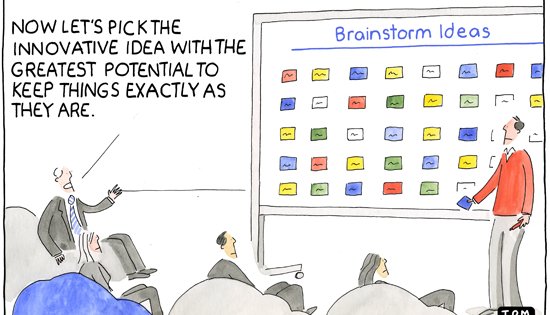
Change- the digital revolution- the dynamic chance to own the future- working smarter with agility and speed!
Many promises are presented to us everyday in the airport, in our media, online, at the train station- all seemingly suggesting that if we approached our work differently with a view to innovation there is a massive reward awaiting each of us. The promises are not new. Allan F. Mogensen on rolling out the Work Simplification theories of the 1930's coined the phrase "Worker Smarter, not Harder," and while he was discussing flow charting and process improvements on the shop floor, the underlying concept of innovation and overall leapfrogging of the competition continues today to be a popular and very profitable theme.
Inevitably, the starting place of the latest "innovation revolution" will lead many a company to revisit both their Strategy and Implementation systems as they look for a way to identify and affect change to reflect new market opportunities.
Strategy implementation can be viewed many ways and the 30 second summary I will provide here divides Strategy formulation and implementation into 4 possible categorizations:
- The organization does not want to risk the costs and efforts of change and thus will define and protect a strategy that stays as close to the status quo as possible.
- The organization is so busy in operational and fire fighting modes that management do not find the time to even properly define much less implement strategy.
- The organization changes with the "flavor of the week" bringing new programs, tools, instruments, consultants, studies, and surveys to the sacrificial altar of implementation- with the stakeholders implicitly acknowledging that by waiting it out there will be another new revolution coming along shortly and in the end nothing will change.
- Systematically management together with their board of directors uses a combination of data, process, and structured input from stakeholders to define and implement a strategy which will be reviewed and updated regularly based on new information and opportunities.
At the moment, one of the themes of the day seems to be for large companies to do their best to act like startups: this conjures exciting images of rapid flexibility, changes on a dime, grabbing opportunities before the competitor even was aware they exist, and generally ignoring the corporate resistance to change that entrenches quite a few companies over time. The theme sounds great, and as with all magic potions needs to be approached with a healthy dose of skepticism. While there are examples of large companies able to perform as startups, this is the exception and not the rule despite what the glossy advertisements may promise.
A balance can exist between startup and movement at the speed of molasses- and it is possible for even the largest corporations to create teams that act very quickly on opportunities and bring positive real change to their company. The most determined of boards and CEOs often see their environment rapidly changing and are able to take advantage of the change to the benefit of the organization by:
An interesting case study today may well be Microsoft which in the past year has moved from a position many considered to be not only stalwart yet increasingly irrelevant to 12 months later becoming one of the most talked about strategic stories of 2015. (Information Week has published a summary which is very interesting to read if you have not yet covered the main points).
Your organization is never too big nor too small to change- and the starting point is recognizing that staying as you are will very rarely bring improved results.




